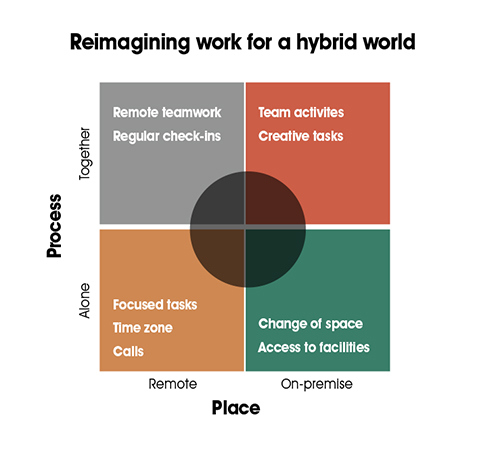While flexible working existed long before Covid-19, the pandemic upped the ante, forcing companies around the world to adopt more flexible working practices. As part of a research project into the implementation of hybrid working, we found that teams and individual employees in almost all the organisations we talked to have significantly more choice about where to work, who to work with and when to work.
This freedom has led to some concern that disconnected working patterns and preferences will lead to worsening productivity and team effectiveness.
Hybrid working: building a sustainable long-term strategy
The secret ingredients of effective hybrid L&D
Businesses look to metaverse to enhance hybrid working
Despite these concerns and having considered the options, most of the organisations in our study were striving towards a hybrid model of working, believing in the importance of the workplace to bring people together, balanced with the flexibility that comes with virtual working.
Our research insights suggest that leaders and managers need to have different conversations with employees to establish new working norms. If hybrid working is to be successful, leaders will need to understand and care about the real needs of employees, and their crucial role as connectors – connecting the needs and preferences of employees with those of the organisation and business.
This requires aligning or integrating the purpose and passions of their people with the mission with that of the organisation.

The connecting leader works with employees and teams to co-design and evolve the hybrid workplace. This doesn’t mean there are no rules or that employees get everything they want, but it does mean that leaders and employees have to share responsibility for building trust and relationships, and establishing new agreed ways of working.
The framework shown above has been developed collaboratively with our research participants to help leaders, teams and individuals to explore and reimagine how and where work can be done in a hybrid world through a series of open conversations.
We have learned from the research that more common assumptions are not always proving to be the case. Some people find it easier to concentrate on individual tasks when outside of their home, some people are more than able to use remote technology to work creatively with others, many people value team meetings being a virtual process.
Exploring these preferences together as a team along with questions such as: How will effective communication happen? And how will we evaluate success? Can we help promote a positive hybrid team environment?
We would encourage leaders and managers to use this framework to facilitate a discussion, at team level, to create a set of clear working practices that achieve a balance between personal preference and what is effective for customers, colleagues and the wider organisation.
The following questions can be used to get started:
1. What work is best done together? This might include creative tasks, team check-ins and information sharing. Make sure to clarify the added value by asking ‘who is benefiting?’
2. Conversely, ask ‘what work is best done alone?’. Encourage the team to share what works well.
3. Introduce the question of the preferred location for that work, to identify how you will bring people together. Use the grid (pictured above) to visualise the team preferences.
4. Once these questions have been discussed, you can ask some of the following questions to enable this to work
in practice:
- What are our space requirements?
- To what extent do we need to schedule our working week collectively?
- What technology do we need for success?
- How will we make ourselves available to others?
- What communication platforms and channels will we adopt?
This way of thinking is not new, with global virtual teams being a source of great practice. One organisation in our study was leveraging the advantage of time zones to plan work so that someone is always working on a task and working together happens at the critical points. Asynchronous working in practice – while one person sleeps the project is still moving forward.
We don’t anticipate these conversations will always be easy, but without them leaders run the risk of making uninformed decisions and putting team engagement, employee wellbeing and productivity at risk.
Managers and leaders will need strong facilitation skills, and some may need external help to have these conversations. This means learning to apply structure and process to team interactions to maximise the collective contributions of the group. It is crucial that differences of opinion are aired, ideas are shared, options are critiqued, and everyone works together to reach agreement.
Debbie Bayntun-Lees and Andy Cross are professors at Hult International Business School (Ashridge)
The full article of the above first appeared in the September/October 2022 print issue. Subscribe today to have all our latest articles delivered right to your desk.







